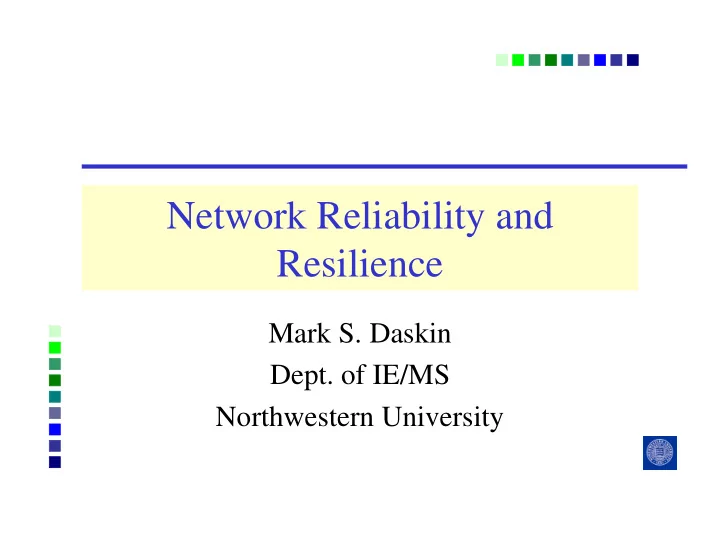

Network Reliability and Resilience Mark S. Daskin Dept. of IE/MS Northwestern University
Reliability and Resilience Reliability Resilience • Low probability of • Consequences of failure failure are designed to be small • Return to normal function is rapid
Outline Framework for network resilience Industry perspectives Examples of research at NU Directions for future work and collaboration
Sources of Supply Chain or Network Unreliability Natural disasters Weather Decreasingly Congestion of facilities Different: random in Business failures •Durations nature •Targets Economics, Energy, •Responses Environment Labor disruptions Terrorist actions We live in an uncertain world.
Reliability/Resilience Taxonomy: Frequency/Severity Frequency Low High Low Severity High
Reliability/Resilience Taxonomy: Duration is also important Frequency – how often does something fail Severity – what fraction Severity of network capability is lost – what is the cost? Duration – how long is Frequency it disabled
Threats and countermeasures Government Intellectual Environmental regulation property concerns Lobbying Supplier Demand Regulation/other R&D/new prod. reliability uncertainty Multi-sourcing Forecasting Inventory Fortification Supplier Firm Firm Firm Terrorism yield Contracts/flex. Market res. Inv./options R&D/options Labor New entrants disruptions products Purchase options Energy Weather Natural availability disasters
Threats and countermeasures Supplier reliability Multi-sourcing Fortification/ Inventory Supplier Intelligence/ Firm Firm Firm Terrorism Detection yield Yield – high frequency, short duration, low consequence, unpredictable Supplier reliability – lower frequency, longer duration, moderate consequence, may be targeted Terrorism – very low frequency, long duration, high consequence, targeted
Threats and countermeasures Weather delay Recovery plans Inducements Fortification Airline Firm Firm Overbooking Terrorism Overbooking – high frequency, few flights impacted, low consequence, somewhat unpredictable Weather delay – lower frequency, longer duration, moderate to high network consequences, may be foreseen Terrorism – very low frequency, very long duration, high consequence, targeted at vulnerable facilities
Event planning is a cycle Pre-event Durin Post event g event
Pre-event planning Prevent events Prevent Prevent Defend against overbooking shortages thru via improved better events (harden forecasting forecasting facilities) Defend against Defend against Design systems terrorism via shortages via to be resilient screening safety stock with respect to Design routes Design failures and networks products for to be robust substitutability; w.r.t. weather networks with delays multiple suppliers
During event Detect events Detect weather Detect shortages by monitoring key problems early Diagnose event suppliers Diagnose severity of Diagnose shortage Prescribe disruption due to severity (total, partial) weather action Prescribe actions Prescribe response (draw on safety stock, Communicate (reroute aircraft, call invoke contracts) in backup crews) action Communicate plans Communicate with plants, suppliers, Coordinate and customers passengers response Coordinate response Coordinate with across system other airlines and Control Control production hotels response Control entire response
Post event Recovery Recovery actions Recovery actions to get production back to reposition actions and marketing to aircraft and crews Redesign recover market share Redesign Redesign supply system for network, routes, chain to mitigate better response aircraft future shortages assignments, Reconstruct (improve response system forecasting, safety system Reconstruct may stock, multi-source) Reconstruct supply not be applicable chain and replenish in weather case safety stocks except in the extreme
Key observations Network effects make pre-event, during event and post-event difficult Solutions must encompass • Detection and Diagnosis • Communication and Coordination • Recovery and Redesign
Questions for Industry How do you think about resilience? How do you ensure resilience? How do you monitor your network(s)? What is the impact of a network failure? How do you contain/recover from failures? What “unmet needs” do you have?
Recommend
More recommend